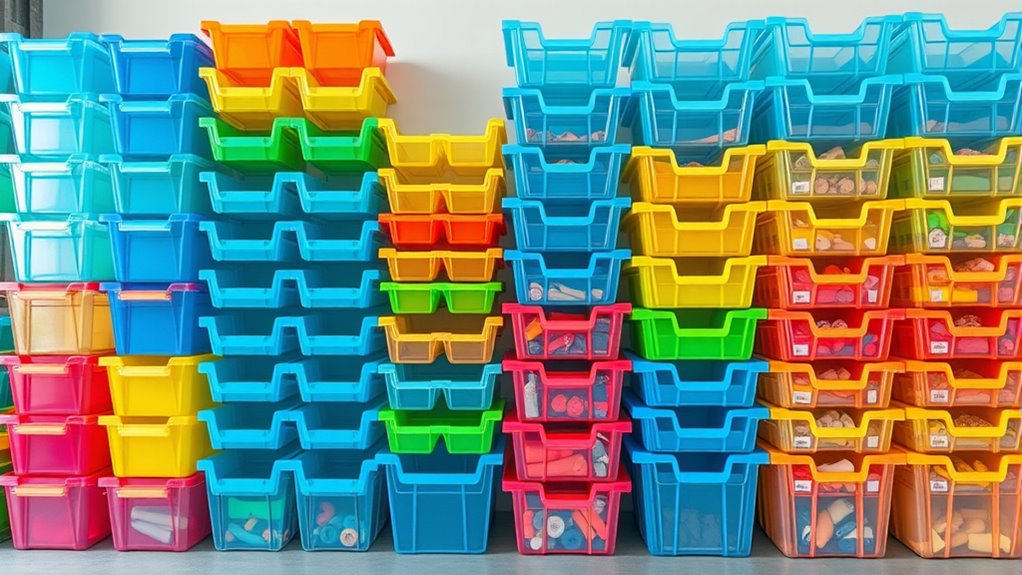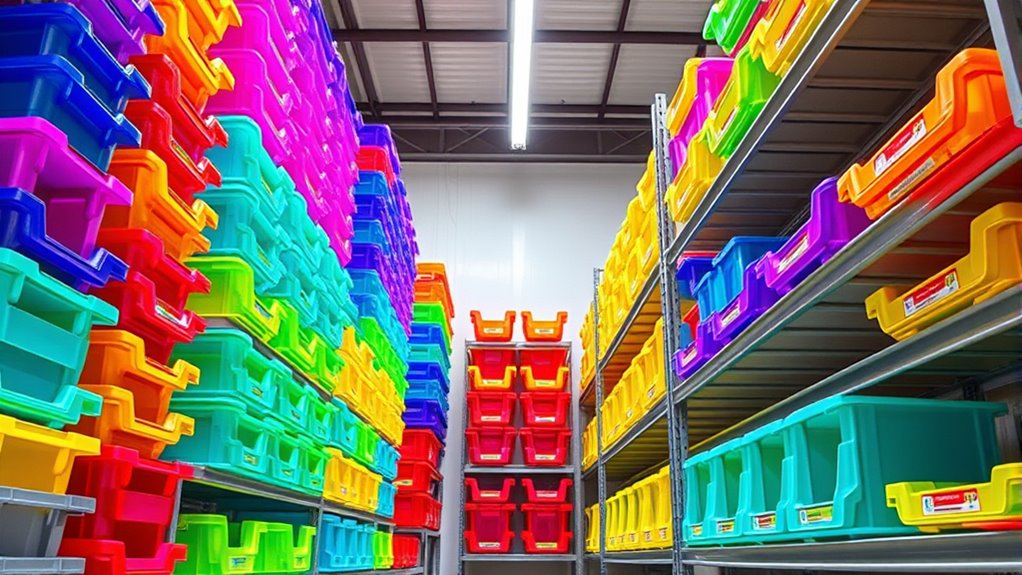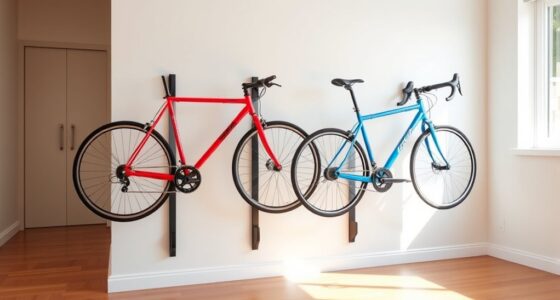To decide whether to stack your bins high or go wide, consider your space layout and how often you access items. Use high stacks in closets or garages for long-term storage, but make sure they’re stable and use lighter items on top. Going wide works best in pantries or craft rooms for quick access and visibility. Combining both methods can maximize your space efficiently. Keep exploring for tips on making your storage safer and more organized.
Key Takeaways
- Use high stacking for vertical space utilization and storing long-term or bulk items safely.
- Opt for going wide for easy access to frequently used or lighter items.
- Combine both methods in areas with varied storage needs to maximize space efficiency.
- Apply clear labels on all bins to enhance visibility and quick retrieval regardless of stacking style.
- Prioritize stability and safety by stacking heavy items low and lighter items high, and ensuring proper support.

Are you looking for an efficient way to organize your space? If so, stackable bins can be a game-changer, but knowing when to stack high and when to go wide makes all the difference. The key lies in understanding your storage needs and applying effective labeling systems to keep everything accessible. By optimizing your space with strategic stacking, you can maximize every inch of your storage area and reduce clutter.
Maximize your storage with strategic stacking and clear labeling for an organized, clutter-free space.
When considering stacking high, think about vertical space. Tall stacks can be perfect if you’re short on floor space but have ample ceiling clearance. Use this approach in areas like closets, garages, or storage rooms where vertical room is underutilized. However, ensure that your bins are stable enough to support height without toppling over. Label each bin clearly with a labeling system that indicates contents, so you don’t have to pull everything out to find what you need. This approach enhances space optimization by keeping items organized and easily retrievable, even in high stacks. Also, consider the weight of items—lighter items are better suited for higher stacking to prevent accidents. Additionally, understanding projector image quality factors like contrast ratio can help you create better visual environments for your viewing experience.
On the other hand, going wide is ideal in situations where accessibility is a priority. If you frequently need to access specific items, spreading your bins out horizontally makes sense. Place bins side by side on shelves or countertops, allowing you to see and reach everything without unstacking multiple containers. This method works well in pantries, craft rooms, or offices, where quick access reduces time spent searching. Incorporate a labeling system that’s visible from the front, so you can identify contents at a glance. Proper labels eliminate the need to open multiple bins, facilitating faster retrieval and better space optimization. Wide stacking also minimizes the risk of toppling, especially when bins are lighter or contents are irregularly shaped.
Ultimately, the choice depends on your space’s layout and your usage habits. If you’re storing long-term items or bulk goods, stacking high might be more efficient. For items you need regularly or frequently, going wide ensures easy access. Combining both methods in different zones of your space can maximize organization and efficiency. Remember, a good labeling system is essential no matter which stacking style you choose. Clear, consistent labels make it easier to find what you need quickly and keep your system running smoothly. With thoughtful planning, you can turn even a cramped area into a well-organized, clutter-free space that’s both functional and visually appealing.
Frequently Asked Questions
How Do I Determine the Maximum Stacking Weight for Bins?
To determine the maximum stacking weight for bins, you need to check the weight capacity listed by the manufacturer. Always pay attention to the stacking limits, which specify how high you can safely stack without risking collapse or damage. Avoid exceeding these limits, as it can compromise stability. Regularly inspecting bins for wear and tear also helps make certain you stay within safe weight capacities and stacking guidelines.
Can Stackable Bins Be Used for Fragile or Delicate Items?
Yes, you can use stackable bins for fragile or delicate contents, but you need to take extra precautions. Make sure the bins are sturdy and have smooth, padded interiors to prevent damage. Use cushioning materials like bubble wrap or foam to protect delicate items, and avoid stacking too high. Properly organizing and securing fragile items guarantees they stay safe during storage or transport, preventing breakage or damage.
Are There Specific Materials Best Suited for Stacking Stability?
Did you know that choosing the right material can increase stacking stability by up to 30%? You should prioritize material compatibility and container durability when selecting stacking bins. Strong plastics like polypropylene or high-density polyethylene offer excellent support and resilience, making them ideal for stacking high or wide. Avoid flimsy materials that can warp or crack under pressure, risking stability and safety.
How Do I Prevent Bins From Slipping or Toppling When Stacked High?
To prevent bins from slipping or toppling when stacked high, focus on proper weight distribution and add anti-slip liners between the bins. Guarantee the heavier items are at the bottom for stability, and use liners to increase grip. Also, make sure the bins are aligned properly, and avoid overloading. These steps help keep your stacks secure and prevent accidents, even when reaching higher heights.
What Maintenance Is Needed to Ensure Long-Term Stacking Safety?
Did you know that improper maintenance causes 40% of stacking accidents? To guarantee long-term safety, you should establish an inspection routine that checks for wear, damage, and stability issues regularly. Focus on correct weight distribution, making sure heavier items are lower to prevent toppling. Keep the bins clean and free of debris, and tighten any loose fittings. Consistent maintenance helps prevent accidents and prolongs the lifespan of your stacking system.
Conclusion
Just like the wise old tree that stretches upward or spreads its branches wide, your storage choices depend on what you value most. When space is limited, stacking high lets you reach for the sky. But if accessibility matters more, going wide keeps everything at your fingertips. Remember, the key is balance—know when to aim for the clouds and when to stay grounded. After all, a well-organized space is your own personal myth of harmony.









